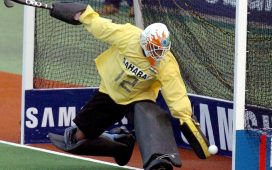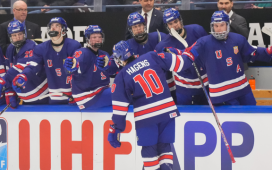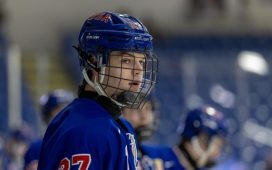On the second weekend of January in the Greater Toronto Area – first in North York, then in Vaughan and later in a to-be-announced location – the Professional Women’s Hockey Players’ Association will undertake its most ambitious Dream Gap Tour event to date. After three successful four-team events and a handful of one-off exhibitions, the Secret Showcase will feature six teams led by some of the world’s best women’s players. Marie-Philip Poulin and Rebecca Johnston will be there. So will Hilary Knight and Brianna Decker. Amanda Kessel and Kendall Coyne Schofield will each captain their own squads.
By virtue of the number of teams, too, this will be the PWHPA’s biggest and most star-studded event yet. Of the 175 players who belong to the PWHPA, the players’ union that was born out of the collapse of the CWHL and the subsequent #ForTheGame movement, 120 will be in attendance, and this event will distinguish itself from the past event in Toronto, the Unifor Showcase on Sept. 21-22, by bringing together a different blend of talent.
“It’s a great way for the majority to be able to come and be together, whether they know each other or don’t, and all be in one place for really the first time,” said Chelsea Purcell, the PWHPA’s Canadian corporate sponsorship consultant. “So, it’s going to be something special. It’s also great because we’re going to look to bring in American players and a couple American teams. I think that’s good, because our last showcase, we only had Canadian teams. We’re really broadening our reach here.”
The showcase, made possible by a partnership with title sponsor Secret, will be the first stop on the second leg of the Dream Gap Tour. After hitting the road for the first time with the aforementioned Unifor Showcase before making stops in Hudson, N.H., and Chicago, this route will begin with the PWHPA’s finest in the GTA and end in Philadelphia, the first tour stop in a locale that is not a home base for a PWHPA regional outfit. Interesting thing about that in-between stop, however: the PWHPA is keeping the location under wraps despite having a title sponsor in place. The issue? They’re waiting to secure the ice time.
“The struggle that we ran into is that this movement happened in May, June, July, we started realizing what we were doing,” Purcell explained. “So everything got booked so late, and all the ice is gone…There’s just the battles you get with booking really late or planning late.”
To a certain extent, the inability to find the necessary ice time has influenced when and where the PWHPA can put on its events. Of course, funding has played a part, too. Said Purcell, the CWHL, in its final season, was run on nearly $4 million. The PWHPA doesn’t have a similar bankroll. The result is that players aren’t playing as much as she – and, you can rest assured, they – would like. “This can’t continue,” she said. “And whether next year there’s no league again, we just need to start planning sooner, which will make things a lot easier.”
And that planning may need to begin in short order. Increasingly, it appears as though the league the PWHPA seeks – one they believe is sustainable, pays the players a livable wage, offers health and medical insurance and has the infrastructure necessary for long-term success – will not be available come next season. Is that a surprise? Not exactly, said Jayna Hefford, the former CWHL commissioner who came aboard as the PWHPA’s operations consultant in August.
“I don’t think any of us thought this was going to be a real easy thing to do,” Hefford said. “Anytime you do something that is purposeful and impactful and really going to be a part of history, it’s not easy. Having an advisor like Billie Jean King, she’s really quick to remind us of this all the time. What she did was not easy, it wasn’t fast and it did take a lot of courage on behalf of the athletes to stand up for what they believe in.”
Recent comments from the NHL, comments that echo what the league office has said throughout this turbulent period in the women’s game, have done little to indicate the PWHPA’s goal is within immediate reach. Responding to The Athletic last week, NHL deputy commissioner Bill Daly said the NHL doesn’t “have a team of people modelling out projections. The league hasn’t (and isn’t) giving consideration to appropriate markets versus markets that might not be ready. We aren’t canvassing specific clubs or owners to gauge their interest in operating franchises.”
Asked about the league’s insistence that nothing was in the works and whether it was at all disheartening, Hefford said the PWHPA has “a great relationship with the NHL, we continue to be in regular communication with them,” adding that while the NHL’s message hasn’t changed, the PWHPA’s goals haven’t, either. And it’s no secret that the PWHPA’s desire is a partnership with the NHL.
“We believe, and history shows us, that being alongside an established league allows women’s professional sport to be successful,” Hefford said. “We see that in the NBA, the National Women’s Soccer League, who had its own challenges for a number of years but now seem to have find some pretty good success alongside the MLS and USA Soccer. So history tells us that…We’re very clear on what our vision is for the future of the sport, what we believe gives us the best opportunity to succeed.”
Unavoidable in any discussion of the roadblocks between the PWHPA and its goal, however, is the presence of the NWHL, the United States-based league that is currently in its fifth season. The NHL’s position is that it has no intention of making a move into the women’s hockey space while there is another league in operation, a position Daly restated in comments to Sportsnet. The NWHL doesn’t look as though it’s going anywhere anytime soon, either. After expanding its schedule ahead of this season, increasing the league’s salary cap and agreeing to a 50-50 split of sponsor-related revenue with the NWHLPA earlier this year, the women’s circuit announced in mid-November that it had “closed a new round of equity funding that ensures viability and continued growth for the league for many years to come.”
So, therein lies the question: if the NHL’s position doesn’t change and the NWHL continues to succeed, what comes next for the PWHPA?
One option would be for the PWHPA to seek a partnership with another league or group that could support the association in reaching its goal. Hypothetically, pairing with the Canadian Hockey League could give the PWHPA not only arenas in which to operate, but readymade fan bases that could offer support to the women’s organizations. Hefford said those aren’t conversations the PWHPA would turn down, but any opportunity that presents itself can’t simply be a quick fix.
“We believe that in order to have that long-term solution, there’s all those elements that need to be in place. It goes back to that knowledge, expertise, infrastructure, resources, all that stuff,” she said. “If that got presented to us, of course we would have that conversation and see if that makes sense for the women.”
Another possibility, especially with more lead time to collect sponsors and do the necessary preparation for a full campaign, would be for the PWHPA to mold itself into something of a pseudo-league. On that, though, Hefford and Purcell are clear.
“(The PWHPA is) not going to morph into a league. That’s not our intent at all,” said Hefford. “Our intent is to provide training opportunities for the women until they have a professional league, and to drive awareness to the need for something like that for these athletes.”
Added Purcell: “We took two steps back with the league folding to take 10 steps forward. And if we took these two steps back and we go back into making another CWHL, we’re just taking either more steps back or going sideways, which is exactly what we don’t want to do.”
Possibly complicating any next step is the upcoming centralization year ahead of the 2022 Beijing Olympics. As Purcell explained, there was always “a high chance” that the PWHPA’s desired league wouldn’t come around this year, but there exists potential for there to be nothing in place by the time star Canadian and American players depart for mid-2021 national team training camps in preparation for the quadrennial tournament. Does that mean anyone interested in backing the league the PWHPA is striving to create will push pause until the world’s best are available full-time in 2022-23?
The reality is that much of what comes next is unknown. It could be said that is among the greatest challenges facing the PWHPA. As Purcell noted, the players have to stick together and stay on the same page, and what is difficult is “having them give up their opportunity to play as much as they could in a league situation.” That’s especially true when the solution isn’t about to present itself overnight.
“We just have to make sure that if this does last more years, we make this into a full business where it’s not just one person running operations because you would need staff to continue to put on these kind of events so the players could continue to play,” Purcell said. “We need more resources, more sponsorship, more partners. I think if we know there’s no league coming, we’ll start preparing for that, start planning. I always say, ‘Prepare for the worst and hope for the best.’ ”
Want more in-depth features, analysis and an All-Access pass to the latest content? Subscribe to The Hockey News magazine.








